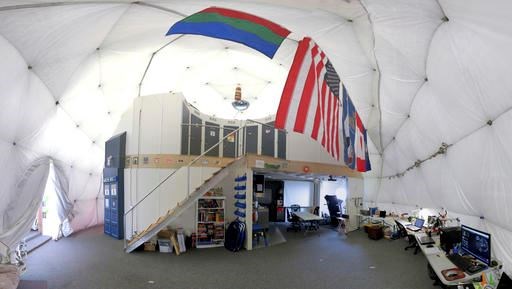 |
| This Aug. 9, 2015 photo provided by the University of Hawaii shows the interior of the domed structure that will house six researchers for eight months in an environment meant to simulate an expedition to Mars, on Mauna Loa on the Big Island of Hawaii. The group will enter the dome Thursday, Jan. 19, 2017, and spend eight months together in the 1,200 square foot research facility in a study called Hawaii Space Exploration Analog and Simulation (HI-SEAS). They will have no physical contact with any humans outside their group, experience a 20-minute delay in communications and are required to wear space suits whenever they leave the compound. (Sian Proctor/University of Hawaii via AP) |
HONOLULU (AP) — A group of NASA-funded researchers are poised to enter an isolated geodesic dome on a Hawaii volcano to study human behavior for long-term space exploration, including a planned voyage to Mars.
The six crew members head into their new home Thursday on the Big Island's Mauna Loa volcano for an eight-month stay. There will be no physical human contact with the outside world, a 20-minute delay in communications to simulate the time it takes for messages to reach earth from Mars and the team will be required to wear space suits whenever they leave the compound.
The study will assess the psychological difficulties associated with living in isolated and confined conditions far away from home. The University of Hawaii operates the facility called Hawaii Space Exploration Analog and Simulation, or HI-SEAS.
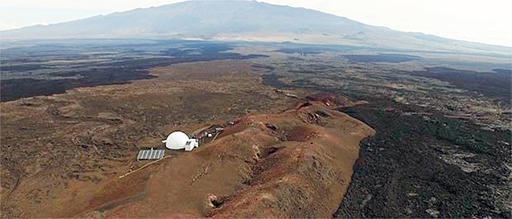 |
| This June, 2015 photo provided by the University of Hawaii shows the domed structure that will house six researchers for eight months in an environment meant to simulate an expedition to Mars, on Mauna Loa on the Big Island of Hawaii. The group will enter the geodesic dome Thursday, Jan. 19, 2017, and spend eight months together in the 1,200 square foot research facility in a study called Hawaii Space Exploration Analog and Simulation (HI-SEAS). They will have no physical contact with any humans outside their group, experience a 20-minute delay in communications and are required to wear space suits whenever they leave the compound. (Sian Proctor/University of Hawaii via AP) |
"We're hoping to figure out how best to select individual astronauts, how to compose a crew and how to support that crew on long-duration space missions," said principal investigator Kim Binstead, a University of Hawaii science professor. The study's goal, she said, is to "reduce the barriers to a human journey to Mars."
There are a number of other Mars simulation projects around the world, but the Hawaii project has been receiving federal funding for several years and is unique, the university says, because of its accessibility, consistent weather and realistic Mars-like geography.
The crew will conduct daily tasks including geological and mapping studies, but will also be required to do more domestic tasks like cooking and cleaning. They will pack in food that has a long shelf life, mostly freeze-dried goods and some canned food.
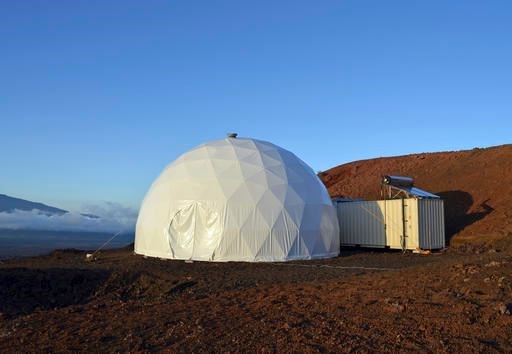 |
| This April 25, 2013 photo provided by the University of Hawaii shows the domed structure that will house six researchers for eight months in an environment meant to simulate an expedition to Mars, on Mauna Loa on the Big Island of Hawaii. The group will enter the geodesic dome Thursday, Jan. 19, 2017, and spend eight months together in the 1,200 square foot research facility in a study called Hawaii Space Exploration Analog and Simulation (HI-SEAS). They will have no physical contact with any humans outside their group, experience a 20-minute delay in communications and are required to wear space suits whenever they leave the compound. (Sian Proctor/University of Hawaii via AP) |
"Spam gets quite popular," Binstead said. The crew will get occasional resupply deliveries that will be recovered by a robot in order to maintain their isolation.
The habitat has small sleeping areas for each crew member as well as a kitchen, laboratory and bathroom. The facility has 1200-square feet of floor space, about the size of a small house.
Leading the crew is mission commander James Bevington, a freelance space researcher who has acted as a visiting researcher for the International Space University and a consultant at Northwestern University. The other team members include engineers, a computer scientist, a doctoral candidate and a biomedical expert. They were selected from a group of 700 applicants with backgrounds in space science.
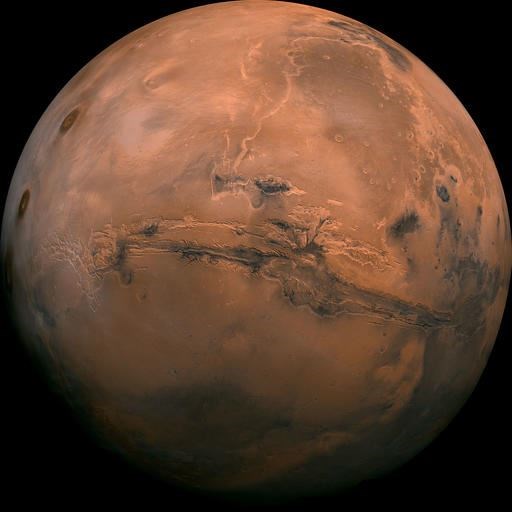 |
| This image provided by NASA shows the planet Mars. A group of NASA-funded researchers are entering an isolated geodesic dome perched on a remote Hawaii volcano to study human behavior for future long-term space exploration, including future trips to Mars. The six crew members entered a dome structure on the Big Island's Mauna Loa Thursday, Jan. 19, 2017, and will spend eight months together in the research facility without physical contact with any other human beings. (NASA via AP) |
"When I started, my biggest fear was that we were going to be that crew that turned out like Biosphere 2, which wasn't a very pretty picture," Bevington said.
Biosphere 2 was an experimental greenhouse-like habitat in Arizona in the 1990s. It housed different natural ecosystems in an effort to study what would be needed for habitation on other planets. The experiment quickly spiraled out of control as the habitat failed to maintain safe levels of carbon dioxide and the crew grew discontent.
The latest HI-SEAS mission is the third round of research funded by NASA. Previous missions focused on food requirements and crew cohesion.
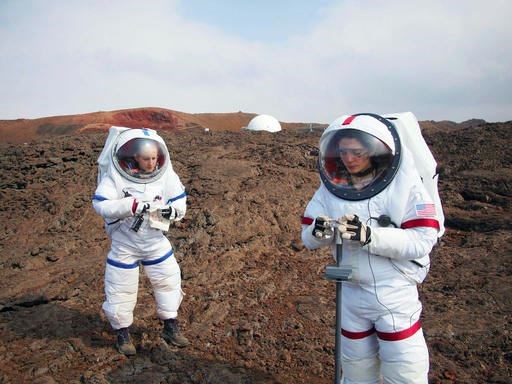 |
| In this May 23, 2014 photo provided by the University of Hawaii, Lucie Poulet, right, uses a geotechnical tool while Annie Caraccio records the data during a previous study outside the domed structure that will house six researchers for eight months in an environment meant to simulate an expedition to Mars, on Mauna Loa on the Big Island of Hawaii. The group will enter the dome Thursday, Jan. 19, 2017, and spend eight months together in the 1,200-square-foot research facility in a study called Hawaii Space Exploration Analog and Simulation (HI-SEAS). They will have no physical contact with any humans outside their group, experience a 20-minute delay in communications and are required to wear space suits whenever they leave the compound. (Ross Lockwood/University of Hawaii via AP) |
This crew will wear devices around their necks that will measure their moods and proximity to other team members. They'll also use virtual reality devices to simulate familiar and comforting surroundings they wouldn't have access to while living on Mars.
The project is designed to help NASA send humans to examine an asteroid by 2025 and to land on Mars sometime in the 2030s.
Binstead said NASA's timeline are realistic unless the agency is "directed to do something different by the new administration."
Trump's transition team did not respond to an emailed request for comment on the incoming administrations view of NASA's Mars plans.
Mars is one of the best places in the solar system to look for signs of past or current life," Binstead said. "And the discovery of life anywhere outside of the earth ... has a claim on being the biggest scientific discovery of all time."
Furthermore, man-made disasters like climate change or natural catastrophes such as an asteroid hit could force a human exodus from Earth.
"Right now, all of our eggs for life are in one basket," Binstead said. "I think it's a good overall strategy for us as a species to spread out further."
Copyright 2017 The Associated Press. All rights reserved.
This material may not be published, broadcast, rewritten or redistributed.
Page created on 1/19/2017 5:38:43 PM
Last edited 1/19/2017 5:38:43 PM





